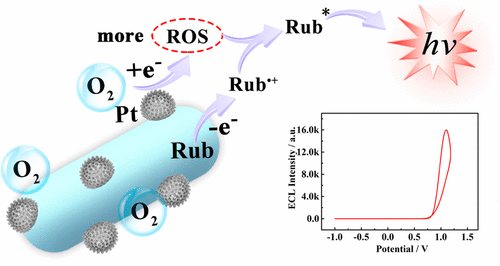当前位置:
X-MOL 学术
›
Anal. Chem.
›
论文详情
Our official English website, www.x-mol.net, welcomes your feedback! (Note: you will need to create a separate account there.)
Ternary Electrochemiluminescence System Based on Rubrene Microrods as Luminophore and Pt Nanomaterials as Coreaction Accelerator for Ultrasensitive Detection of MicroRNA from Cancer Cells
Analytical Chemistry ( IF 6.7 ) Pub Date : 2017-08-21 00:00:00 , DOI: 10.1021/acs.analchem.7b01812 Jia-Li Liu 1 , Zhi-Ling Tang 1 , Ying Zhuo 1 , Ya-Qin Chai 1 , Ruo Yuan 1
Analytical Chemistry ( IF 6.7 ) Pub Date : 2017-08-21 00:00:00 , DOI: 10.1021/acs.analchem.7b01812 Jia-Li Liu 1 , Zhi-Ling Tang 1 , Ying Zhuo 1 , Ya-Qin Chai 1 , Ruo Yuan 1
Affiliation

|
As the only endogenous coreactant in the electrochemiluminescence (ECL) system, the dissolved O2 was the ideal candidate due to the mild reaction and easy operation, but compared to S2O82–, the dissolved O2 with weaker redox activity suffers from the poor enhancement effect of the luminophore, which restricted the further application in bioanalysis. Here, a high-intense ECL signal was gained by the employing of Pt nanomaterials as a coreaction accelerator to generate more of the intermediate of dissolved O2 to promote the coreaction efficiency. On the basis of a new ternary ECL system of Pt nanomaterials as the coreaction accelerator, dissolved O2 as the coreactant, and a neotype rubrene microrods as the luminophore, an efficient “on–off–on” solid-state ECL switch platfrom was designed for ultrasensitive microRNA (miRNA) detection with a background reduction strategy of ferrocene-labeled single-stranded DNA (Fc-DNA) as a quencher. In the presence of miRNA 141, the Pt nanoparticles labeled hairpin (HP1/PtNPs) was opened to produce plenty of Pt nanoparticles labeled output DNA (S1/PtNPs) and release the miRNA-141 to participate in the next cycle. Then, the S1/PtNPs were captured on the surface of the electrode by the complementary strand to obtain the super “signal on” state with extremely high ECL signal. This novel solid-state ECL platform exhibited excellent sensitivity from 10 aM to 100 pM with a detection limit of 2.1 aM, which provided a new approach for ultrasensitive ECL bioanalysis.
中文翻译:

基于钌微棒作为发光体和Pt纳米材料作为共作用促进剂的三级电化学发光系统,用于从癌细胞中超敏感地检测MicroRNA。
作为电致发光(ECL)系统中唯一的内源性共反应物,溶解的O 2由于反应温和且易于操作而成为理想的候选物,但与S 2 O 8 2–相比,氧化还原活性较弱的溶解的O 2具有以下缺点:发光体的增强效果差,限制了其在生物分析中的进一步应用。在这里,通过使用Pt纳米材料作为共作用促进剂来产生高强度的ECL信号,以产生更多的溶解的O 2中间体,从而提高了共作用效率。在以Pt纳米材料为共作用促进剂的新型三元ECL体系的基础上,溶解了O 2作为一种共激活剂,一种新型的红荧烯微棒作为发光体,设计了一种高效的“ on-off-on”固态ECL开关平台,用于超敏感的microRNA(miRNA)检测,并采用二茂铁标记的单链DNA的背景还原策略(Fc-DNA)作为淬灭剂。在存在miRNA 141的情况下,将Pt纳米颗粒标记的发夹(HP1 / PtNPs)打开,以产生大量的Pt纳米颗粒标记的输出DNA(S1 / PtNPs),并释放miRNA-141以参与下一个周期。然后,S1 / PtNPs被互补链捕获在电极表面,从而获得具有极高ECL信号的超级“信号开启”状态。这个新型的固态ECL平台在10 aM至100 pM的灵敏度范围内具有2.1 aM的检测极限,为超灵敏ECL生物分析提供了一种新方法。
更新日期:2017-08-22
中文翻译:

基于钌微棒作为发光体和Pt纳米材料作为共作用促进剂的三级电化学发光系统,用于从癌细胞中超敏感地检测MicroRNA。
作为电致发光(ECL)系统中唯一的内源性共反应物,溶解的O 2由于反应温和且易于操作而成为理想的候选物,但与S 2 O 8 2–相比,氧化还原活性较弱的溶解的O 2具有以下缺点:发光体的增强效果差,限制了其在生物分析中的进一步应用。在这里,通过使用Pt纳米材料作为共作用促进剂来产生高强度的ECL信号,以产生更多的溶解的O 2中间体,从而提高了共作用效率。在以Pt纳米材料为共作用促进剂的新型三元ECL体系的基础上,溶解了O 2作为一种共激活剂,一种新型的红荧烯微棒作为发光体,设计了一种高效的“ on-off-on”固态ECL开关平台,用于超敏感的microRNA(miRNA)检测,并采用二茂铁标记的单链DNA的背景还原策略(Fc-DNA)作为淬灭剂。在存在miRNA 141的情况下,将Pt纳米颗粒标记的发夹(HP1 / PtNPs)打开,以产生大量的Pt纳米颗粒标记的输出DNA(S1 / PtNPs),并释放miRNA-141以参与下一个周期。然后,S1 / PtNPs被互补链捕获在电极表面,从而获得具有极高ECL信号的超级“信号开启”状态。这个新型的固态ECL平台在10 aM至100 pM的灵敏度范围内具有2.1 aM的检测极限,为超灵敏ECL生物分析提供了一种新方法。











































 京公网安备 11010802027423号
京公网安备 11010802027423号